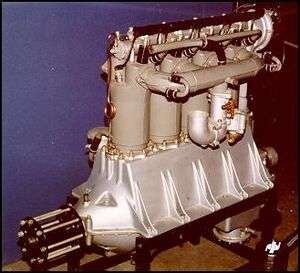Liberty L-4
The Liberty L-4 was a four-cylinder water-cooled inline aircraft engine developed in the United States during World War I. The Liberty L-4 was an experimental engine of 102 hp (76 kW), built by the Hudson Motor Car Company and intended primarily for use in training airplanes. Only two were produced, since other types of engines were available and already in production. It is unknown if the L-4 was ever test-flown.
| Liberty L-4 | |
|---|---|
 | |
| Liberty L-4 aircraft engine | |
| Type | Piston aero engine |
| National origin | United States |
| Manufacturer | Hudson |
| Designed by | Jesse G. Vincent and Elbert J. Hall |
| First run | c.1917 |
| Variants | Liberty L-6, Liberty L-8, Liberty L-12 |
Specifications
General characteristics
- Type: Four-cylinder inline piston engine
- Bore: 5 in. (127mm)
- Stroke: 7 in. (177.8mm)
- Displacement: 549.8 cuin (9.0 L)
Components
- Cooling system: Water-cooled
Performance
- Power output: 102 hp
gollark: +<markov
gollark: Oh. Epicbot is broken.
gollark: +<markov
gollark: -- is test ABR. ++ is true ABR.
gollark: When I started taking programming course, I was super excited, but soon after being surrounded by monster Macron, I lost the joy of programming, but after discovering osmarkslisp™, programming is fun again!
References
This article incorporates text from Liberty L-4, a public domain work of the United States Government.
- Gunston, Bill (1986). World Encyclopedia of Aero Engines. Wellingborough: Patrick Stephens. p. 106.
This article is issued from Wikipedia. The text is licensed under Creative Commons - Attribution - Sharealike. Additional terms may apply for the media files.